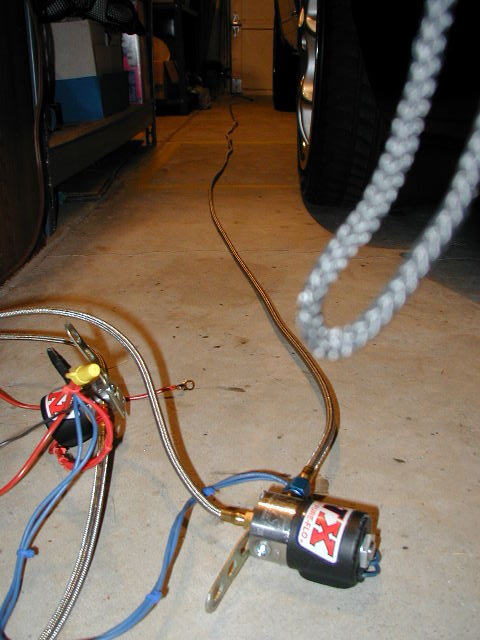Nitrous Express Parts
Nitrous Oxide can definitely give a 928 some kick. My PO had
installed this Nitrous Express setup. The car at some point developed
a number of problems that caused it to not perform properly. These
problems included vacuum leaks (resulting in poor idle and rough running)
and disconnected knock sensors (resulting in incorrect engine timing).
Additionally the tuned intake flap was inoperative.
As a result non-NO2 dyno runs were poor (234/242 hp/torque). However,
NO2 dyno runs using 150hp jets were 351/433 hp/torque. The only
other mods were an RMB and a cat-bypass.
The PO took me for a ride with the car in this state, although
the flappy problem had been corrected. The amount of kick was
incredible! It was about 10:00 one night and we headed down a local
winding road. At about 50mph he floored the accelerator and the rear end
broke loose!! The power was awesome. Whew! I think I stopped having
a heart-attack sometime the next day. Talk about being pushed back in
your seat!!!! It's scary to think of the power that would be had in a
properly running 928......!
After I bought the car, I removed the NO2 setup. In order to
troubleshoot the various problems I felt it best to remove the
unknowns. Plus, I personally have little use for NO2 in my typical
driving - I am perfectly happy with the power of my now-correctly-running
S4 (I have enough trouble keeping the rear from breaking loose
as it is...). ALSO, NO2 is for the experienced! It can be very
dangerous if mishandled. I have children with plenty of their toys
in the garage (besides mine) and I just did not want to have a *loaded
gun* sitting around! Check
this out!

Here you can see the long line which runs from
the engine compartment to the NO2 tank, which had been
located in the right rear seat. A whole had been punched
through the floor and the line run alongside the fuel line.

All the pieces.

This is located on the red line which is fed from the fuel
line.

The fuel line was tapped next to the upper shock housing. Maybe
there's a good reason for this, I don't know. Personally I might have
gone for the black rubber hose section.

Another view of the fuel line tap.

This is on the blue line which runs to the NO2 tank.

The red and blue lines merge to this nozzle. A hole had been drilled
into the right side dead center of the MAF sensor. It is very
important that this hole and fitting be sealed so that the
there are no air leaks.

These are the various switches. The red switch was to "arm"
the system and turn it on. Actually only one of the
beige toggle switches was used (the other was for an air/fuel
meter). The one beige toggle switch turned on a bottle warmer
(which must be part of the bottle which the PO kept). The
bracket switch was mounted on the throttle housing.
More pictures are located at
http://members.rennlist.com/clays928/nos.html
John Pirtle
February 8, 2001
S4 Page







